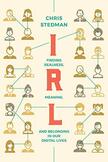Review: Can we find real community online?
As we move into the second year of the Covid-19 pandemic, shifting our work and personal lives from “real life” to working and socializing almost entirely online, the question of how our identities are changing because of increased time in digital spaces is more timely than ever. Chris Stedman, who has spent years thinking and writing about online life and its impact on our ideas of self and interpersonal relationships, is the perfect guide to unpacking what identity means in the digital age with his new book, IRL: Finding Realness, Meaning, and Belonging in Our Digital Lives.
A breakup and an unexpected illness led Stedman on a quest to understand the psychology and sociology behind how our online identities are constructed through social media. As a gay teen, he found on the internet spaces to share his identity with other L.G.B.T. young people; but as an adult, he often found himself editing and censoring his personality in social media posts.
This narrative of a curated, performed identity feels particularly poignant in the pandemic, when many of us rely on the internet for social connection instead of finding it “in real life” (the “IRL” of the title). On one social media platform, like Instagram, we might be more concerned with filters and making our lives appear desirable and attractive. On another, like Facebook, we might be rolling our eyes at someone’s political posturing even while we’re doing our own political posturing. On Twitter, we’re probably trying to make the snappiest comebacks and snarkiest jokes while dunking on people whose opinions we think are ridiculous, all while espousing our own ridiculous opinions.
The more we perform and curate an identity online, the more we lose touch with the flawed, human part of ourselves that craves connection in the first place.
But none of these things presents any kind of whole or authentic self to the world, just fragments of our personalities that shift and change depending on the medium or the minute. As much of a bricolage as they are, the digital pieces of our lives, according to Stedman, can form “a mirror that reveals what we’re attached to, what scripts we follow, and how we understand ourselves.”
Stedman admits that while online life may offer “profound new opportunities to see things about ourselves,” it also leads us to an “impulse to broadcast an edited image of ourselves.” His accounts of the meaning of selfies at different times, and the impulse to take them in the first place, are both touching and funny because so many of us have also used this form of self-portraiture to share our “real” emotions with the world, only to slap on layers of filters until the person in the photo is no longer recognizable.
FOMO, the “fear of missing out” that we experienced before the pandemic when looking at other people’s Instagrammed dinners and vacations, has only become a more painful sensation because we know those dinners and vacations are now putting people’s lives at risk. But a photo of a person eating alone, traveling alone or watching Netflix alone doesn’t feel worth sharing when no one is going to “like” that part of our lives. The more we perform and curate an identity online, the more we lose touch with the flawed, human part of ourselves that craves connection in the first place.
Of course, this longing for connection and its impact on how we behave is not exclusive to online spaces or to the pandemic. There is always going to be a “public-facing” version of ourselves, ironed and polished and groomed, and a private version, sloppily cleaning our fingers of Cheeto dust by wiping them on our sweatpants. While there are obvious psychological and social ramifications to the ways the internet compounds our sense of having a divided identity, Stedman’s book adds another layer to his blend of storytelling, research and investigative journalism: spirituality.
As the former humanist chaplain at Yale and Harvard and the author of a previous book, Faitheist, that made the case for nonreligious people being included in conversations about faith and spirituality, Stedman has been writing about the meaning of faith and religion for years. He is an expert guide for readers who are moving through the shifts many people are making from religious affiliation to seeking “meaning, purpose, and a sense of realness” on the margins of (or outside of) religions, including in online communities. In the pandemic, when we cannot gather in person, many people have felt their ties to religion fraying and fracturing. How the internet plays a role in this disaffiliation is a question Stedman wrestles with and unpacks throughout the book.
While the internet is full of pitfalls, it is still capable of connecting us to one another and of helping us deepen our relationships to ourselves through self-reflection.
Younger adults, who increasingly identify as religious “nones,” use the internet not just to find the kind of community religion used to provide before American religion became politically polarized, but also to find civic engagement and socializing. But, according to Stedman, nones also embrace the internet for its potential to help us know ourselves better. “New elements of our humanity may emerge” from our collective movement toward more individualized identities, but the view into other people’s very different lives that the internet offers us may be “an important part of becoming more fully human.”
In these pandemic days, however, all of us, regardless of religious identity or lack thereof, are seeking the same things online: connection, guidance, solidarity. But who we are when we go looking, and how the internet changes our sense of self, are the ideas Stedman’s book can help us untangle. Writers and philosophers from Marcus Aurelius to Thomas Merton have wrestled with this notion of the “authentic” self. Stedman’s book is another guide to help us move past the idea that simply sharing things on the internet is enough to connect us, and into using that same internet sharing as a space for vulnerability that might actually open us up to more authentic relationships online.
Stedman reminds us, however, that authenticity can happen only with an understanding of how the internet actually works, how it is designed to be addictive and to make us want to buy things. “The irony of turning to profit-motivated platforms for meaning and belonging,” he says, is that those very platforms are the things currently helping us to understand our own desires and longings. The more we are able to be aware of the dangers online life poses to our quest for self-knowledge, the more we can enable ourselves and others to avoid those dangers.
Ultimately, Stedman leads us to understand that while the internet is full of pitfalls, it is still capable of connecting us to one another and of helping us deepen our relationships to ourselves through self-reflection. “If you believe that understanding the experiences of people who are different from you is an important part of becoming more fully human,” he writes, the ties we can build online are essential. But this requires an effort to “use social media well, to wield its power carefully and mindfully.” In a moment when many of those in power have been doing the opposite, and doing damage as a result, Stedman’s humorous, thoughtful guide to how we can rehumanize the online world is needed more than ever.
This article also appeared in print, under the headline “Finding Community Online,” in the Spring Literary Review 2021, issue.











